The dual-specificity protein phosphatase Yvh1p regulates sporulation, growth, and glycogen accumulation independently of catalytic activity in Saccharomyces cerevisiae via the cyclic AMP-dependent protein kinase cascade
- PMID: 10852885
- PMCID: PMC101947
- DOI: 10.1128/JB.182.12.3517-3528.2000
The dual-specificity protein phosphatase Yvh1p regulates sporulation, growth, and glycogen accumulation independently of catalytic activity in Saccharomyces cerevisiae via the cyclic AMP-dependent protein kinase cascade
Abstract
Yvh1p, a dual-specific protein phosphatase induced specifically by nitrogen starvation, regulates cell growth as well as initiation and completion of sporulation. We demonstrate that yvh1 disruption mutants are also unable to accumulate glycogen in stationary phase. A catalytically inactive variant of yvh1 (C117S) and a DNA fragment encoding only the Yvh1p C-terminal 159 amino acids (which completely lacks the phosphatase domain) complement all three phenotypes as well as the wild-type allele; no complementation occurs with a fragment encoding only the C-terminal 74 amino acids. These observations argue that phosphatase activity is not required for the Yvh1p functions we measured. Mutations which decrease endogenous cyclic AMP (cAMP) levels partially suppress the sporulation and glycogen accumulation defects. In addition, reporter gene expression supported by a DRR2 promoter fragment, containing two stress response elements known to respond to cAMP-protein kinase A, decreases in a yvh1 disruption mutant. Therefore, our results identify three cellular processes that both require Yvh1p and respond to alterations in cAMP, and they lead us to suggest that Yvh1p may be a participant in and/or a contributor to regulation of the cAMP-dependent protein kinase cascade. The fact that decreasing the levels of cAMP alleviates the need for Yvh1p function supports this suggestion.
Figures
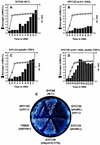

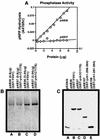


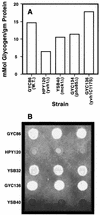

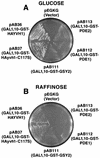
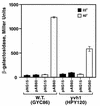
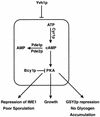
Similar articles
-
The S. cerevisiae nitrogen starvation-induced Yvh1p and Ptp2p phosphatases play a role in control of sporulation.Yeast. 1996 Sep 15;12(11):1135-51. doi: 10.1002/(sici)1097-0061(19960915)12:11<1135::aid-yea11>3.0.co;2-l. Yeast. 1996. PMID: 8896280
-
The dual-specificity protein phosphatase Yvh1p acts upstream of the protein kinase mck1p in promoting spore development in Saccharomyces cerevisiae.J Bacteriol. 1999 Sep;181(17):5219-24. doi: 10.1128/JB.181.17.5219-5224.1999. J Bacteriol. 1999. PMID: 10464190 Free PMC article.
-
Dual-specificity protein phosphatase Yvh1p, which is required for vegetative growth and sporulation, interacts with yeast pescadillo homolog in Saccharomyces cerevisiae.Biochem Biophys Res Commun. 2001 Nov 30;289(2):608-15. doi: 10.1006/bbrc.2001.6021. Biochem Biophys Res Commun. 2001. PMID: 11716519
-
Genetic interactions of ribosome maturation factors Yvh1 and Mrt4 influence mRNA decay, glycogen accumulation, and the expression of early meiotic genes in Saccharomyces cerevisiae.J Biochem. 2011 Jul;150(1):103-11. doi: 10.1093/jb/mvr040. Epub 2011 Apr 6. J Biochem. 2011. PMID: 21474464
-
Novel sensing mechanisms and targets for the cAMP-protein kinase A pathway in the yeast Saccharomyces cerevisiae.Mol Microbiol. 1999 Sep;33(5):904-18. doi: 10.1046/j.1365-2958.1999.01538.x. Mol Microbiol. 1999. PMID: 10476026 Review.
Cited by
-
MoYvh1 subverts rice defense through functions of ribosomal protein MoMrt4 in Magnaporthe oryzae.PLoS Pathog. 2018 Apr 23;14(4):e1007016. doi: 10.1371/journal.ppat.1007016. eCollection 2018 Apr. PLoS Pathog. 2018. PMID: 29684060 Free PMC article.
-
Characterization of a human cell line stably over-expressing the candidate oncogene, dual specificity phosphatase 12.PLoS One. 2011 Apr 20;6(4):e18677. doi: 10.1371/journal.pone.0018677. PLoS One. 2011. PMID: 21556130 Free PMC article.
-
Mutational Analyses of the Cysteine-Rich Domain of Yvh1, a Protein Required for Translational Competency in Yeast.Biology (Basel). 2022 Aug 22;11(8):1246. doi: 10.3390/biology11081246. Biology (Basel). 2022. PMID: 36009873 Free PMC article.
-
Assembling the components of the quorum sensing pathway in African trypanosomes.Mol Microbiol. 2015 Apr;96(2):220-32. doi: 10.1111/mmi.12949. Epub 2015 Mar 4. Mol Microbiol. 2015. PMID: 25630552 Free PMC article. Review.
-
Characterization of Single Gene Deletion Mutants Affecting Alternative Oxidase Production in Neurospora crassa: Role of the yvh1 Gene.Microorganisms. 2020 Aug 4;8(8):1186. doi: 10.3390/microorganisms8081186. Microorganisms. 2020. PMID: 32759834 Free PMC article.
References
-
- Botstein D, Falco S C, Stewart S E, Brennan M, Scherer S, Stinchomb D T, Struhl K, Davis R W. Sterile host yeasts (SHY): a eukaryotic system of biological containment for recombinant DNA experiments. Gene. 1979;8:17–24. - PubMed
Publication types
MeSH terms
Substances
Grants and funding
LinkOut - more resources
Full Text Sources
Molecular Biology Databases

